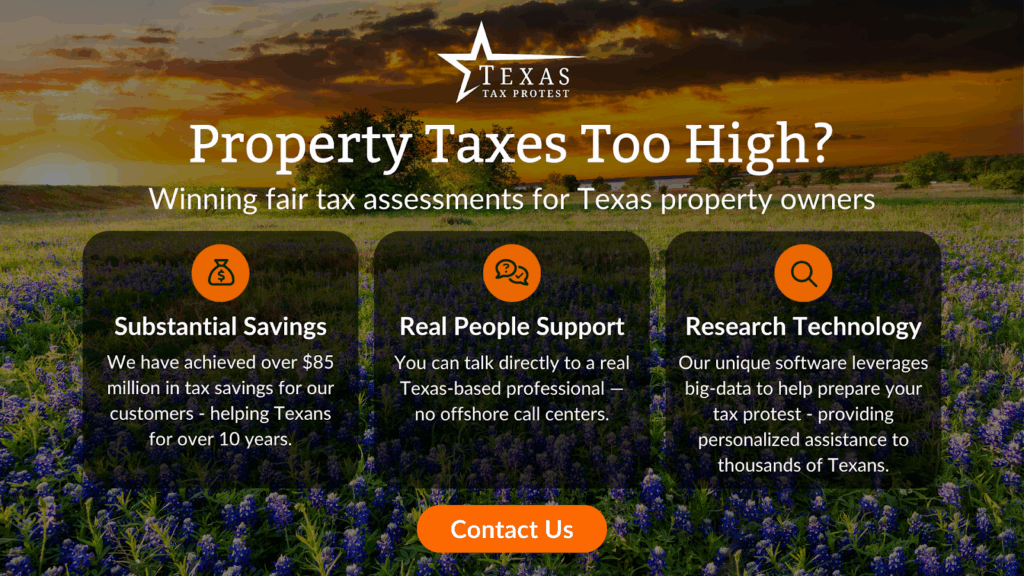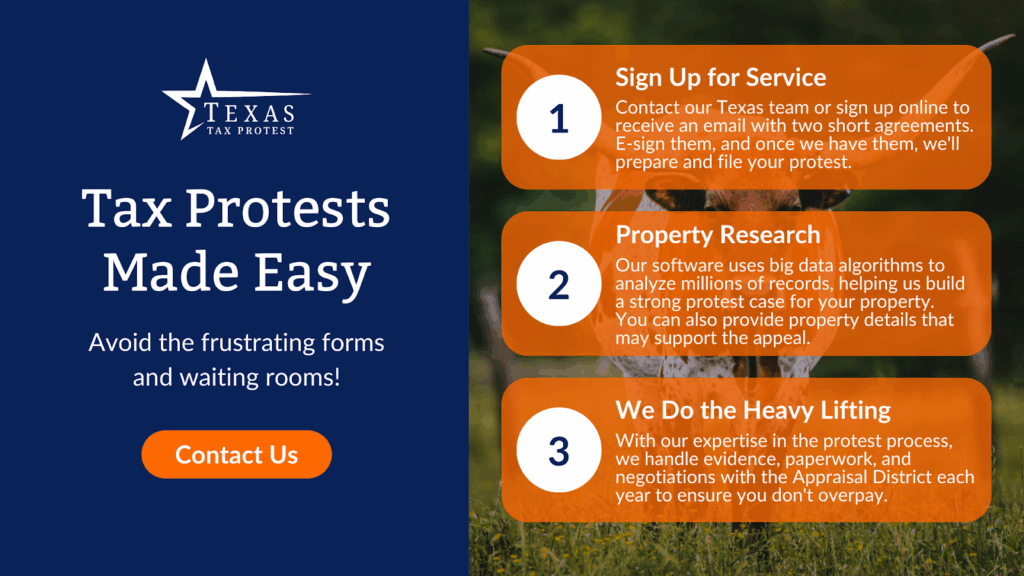
Where Are the Highest and Lowest Property Taxes in Texas?
August 17, 2025
Key Takeaways:
- Texas Property Tax Rates Vary: Counties like King, Collin, and Travis sit at the high end, while places like Terrell, Ward, and Zavala land on the lower side. These differences often come down to local budgets, property values, and how services are funded in each community.
- Key Factors Shape What You Owe: Local school investments, bond measures, appraisal methods, and tax base diversity all influence how rates are set. Knowing what drives those numbers can help you make sense of your bill and how to challenge it when something feels off.
- Steps You Can Take to Fight Inflated Appraisals: From researching comps to correcting errors or filing for exemptions, a strong protest strategy can lead to meaningful savings. Our team at Texas Tax Protest is here to walk you through it and help push for a fairer valuation.
If you’ve wondered why your neighbor’s property tax bill feels eerily different from yours, even though you live in Texas, this is where the answer is. In Texas, tax rates can swing wildly from one county, city, or school district to the next. The idea of a single “Texas property tax rate” is a myth. Instead, a patchwork of local taxing authorities and careful assessments creates a complex landscape determining how much you’ll owe yearly.
In this article, we’ll zoom in on the Texas property tax rate map, break down the regions with the highest and lowest taxes, and decode what those numbers mean for you. With Texas Tax Protest’s professional guidance, you’ll learn how tax rates are determined and take actionable steps to better navigate your next property tax bill, minus the legal jargon.
Top 5 Texas Counties with the Highest Property Taxes
Some counties across Texas consistently report higher tax bills – not because of policy alone, but due to rising property values, suburban growth, and how much local governments depend on those taxes to fund infrastructure, schools, and public services. Here’s a closer look at five counties where median property taxes climb well above the state average.
1. King County: Sparse Population, Strong Valuations
King County is one of the most populous counties in Washington, with just over 2.3 million people. Its median home value stands at $761,500, and the average homeowner pays around $6,476 per year in property taxes – reflecting an effective tax rate of approximately 0.85%, not the higher rate suggested.
2. Collin County: Booming Suburbs, Growing Demand
Homeowners in Collin County now pay a median annual property tax of approximately $6,925, based on a median home value of $496,962 and an effective tax rate of 1.49%. This reflects the strain of rapid suburban growth, especially in cities like Plano and Frisco, driven by the need to fund schools, public safety, infrastructure, and road expansion.
3. Fort Bend County: Rapid Development, Rising Appraisals
As one of the fastest-growing counties surrounding Houston, Fort Bend homeowners now face an average annual property tax bill of $6,787, tied to a median home value of $329,600, translating to an effective tax rate of 2.06%. The layered tax structure – encompassing school districts, water authorities, and county services – drives revenue needs. Rapid suburban expansion through master-planned communities in Sugar Land, Cinco Ranch, and elsewhere continues to push appraised values higher year over year.
4. Rockwall County: Small Size, Big Investment
Nestled just east of Houston, Fort Bend County has seen substantial suburban development. Homeowners now pay a median property tax of around $6,787, based on a median home value of $329,600, resulting in an effective tax rate of 2.06%. The county’s layered tax structure supports extensive investments in school districts, water systems, and local infrastructure, driven by rapid growth in areas like Sugar Land and Cinco Ranch.
5. Travis County: Urban Services, Expanding Footprint
Anchored by Austin, Travis County homeowners now pay an average annual property tax of approximately $6,783, based on a median home value of roughly $347,700, yielding an effective tax rate of ~1.95%. The tax burden reflects the combined funding needs of the city, county, and multiple school districts, and continues to rise with Austin’s real estate boom.

Top 5 Texas Counties with the Lowest Property Taxes
Across Texas, there are still places where homeowners pay a fraction of what urban dwellers do in annual property taxes. These counties often have smaller populations, more modest home values, and fewer municipal services to fund. Here’s a breakdown of where property taxes stay remarkably low.
1. Terrell County: Light Demand, Lower Tax Burden
In West Texas, Terrell County reports the state’s lowest median property tax at $285. The median home value is $42,600, while the average tax rate is 0.67%. With limited development and minimal public service infrastructure, residents in this remote region shoulder a much lighter tax responsibility compared to those in larger counties.
2. Ward County: Oil Country with Modest Taxes
Located in the Permian Basin region, Ward County has a median home value of $138,800. Homeowners pay around $3,408 annually in property taxes, translating to an effective tax rate of approximately 2.46%. While the local economy is driven primarily by oil production, residential tax burdens remain moderate. Statewide data show most homeowners in the county fall into the sub-$800 tax bracket, but those with median‑valued homes pay in the $3,000‑$4,000 range.
3. Upton County: Fewer Services, Lower Bills
Upton County’s rural setting contributes to a median property tax of $442. With median home values of $35,460 and a tax rate of around 1.73%, the area sees minimal valuation or tax needs spikes. A lean budget structure and low-density development keep rates steady for longtime residents.
4. Zapata County: South Texas Savings
Bordering Mexico, Zapata County posts a median tax of $359, a home value of $47,100, and a tax rate of 0.76%. The region’s slower housing growth and limited municipal service expansion help keep property taxes among the lowest in the state, offering relief for rural homeowners.
5. Zavala County: Conservative Appraisals, Community Roots
In Zavala County, the median property tax stands at $369. Homes in the area hold a median value of $36,900, with the average tax rate sitting right at 1.00%. While the rate appears higher than in some nearby counties, the significantly lower home values keep annual bills manageable. Long-established communities and a steady cost of living contribute to the area’s tax stability.

Factors Influencing Property Tax Rates Across Texas
Property tax rates don’t rise or fall at random. They reflect local needs, economic shifts, and how each community funds services. Here’s a breakdown of the factors that shape those rates from county to county:
- School Spending and Local Budgets: Without a state income tax to fall back on, Texas leans heavily on property taxes to fund public services. Local governments and school districts rely on this revenue to cover essentials like education, emergency services, and infrastructure.
- Property Values and Appraisal Adjustments: What you pay depends largely on how your property is valued. Appraisal districts look at recent home sales nearby and adjust for things like square footage, location, renovations, and condition.
- Exemptions and Tax Relief Options: Texas offers a range of exemptions, including those for homesteads, seniors, disabled individuals, and veterans. When more residents claim these exemptions, taxable values drop across the board. That said, claiming the right exemption requires awareness and action.
- Business Growth and Economic Mix: Areas with diverse tax bases, such as a blend of commercial properties, residential neighborhoods, and industrial zones, tend to distribute the tax load more evenly. In rural counties with fewer businesses, homeowners may carry more of the burden, which leads to higher residential rates.
- Bond Measures and Special District Add-Ons: When voters approve local bond initiatives, the costs appear on tax bills. These might fund new school buildings, hospital expansions, road improvements, or park upgrades. Special-purpose districts, such as utility or flood control zones, often have their own rates, too.
Strategies for Reducing Your Property Tax Burden
High property tax rates can catch homeowners off guard, but there are practical steps that may lead to a lower bill. From reviewing comps to correcting errors, knowing your options gives you a stronger footing, and our team at Texas Tax Protest is here to help you use those options wisely.
Dig into Local Comps
One of the most effective ways to challenge your valuation is by studying recent sales of similar properties in your area. Focus on homes or commercial buildings with comparable square footage, layout, age, and features. Appraisal districts use this same approach, often called “comparable sales analysis.”
When reviewing comps, remember to apply mathematical adjustments. For example, if your lot is smaller than the comp, that difference should reduce the comp’s value during comparison. The same goes for upgrades like a renovated kitchen or a detached garage. These details help reveal where your property may be inflated.
Catch Inaccuracies in Your Appraisal
Appraisal errors are more common than most people realize. Review your notice carefully for mistakes in square footage, construction year, property type, or amenity listings. Even a small oversight like a misrecorded pool or missing room can inflate your appraised value. These errors directly affect how much you owe, so correcting them is an important first step in any protest.
Apply for All Exemptions You Qualify For
Exemptions reduce your taxable value, and claiming the right ones can lead to substantial savings. Texas homeowners may qualify for a homestead exemption or additional reductions for age, disability, or military service. County-level guidelines vary, so you’ll need to check local eligibility rules. Once granted, these exemptions cut down the portion of your home’s value that gets taxed.
Prepare a Protest That Stands Up to Scrutiny
Every county sets a deadline for filing property tax protests – miss it, and the opportunity slips until next year. Filing a protest doesn’t require legal credentials, but it does require preparation. A strong protest includes clear documentation, relevant comps, and evidence supporting a reduced valuation. Our team at Texas Tax Protest specializes in assembling this kind of case.
Follow Market Shifts in Your Area
Local market trends can shift quickly, particularly in neighborhoods experiencing development or transition. Staying on top of sales activity, zoning changes, or renovation trends can help you argue that your property was overvalued using outdated data. The more informed you are, the better equipped you’ll be when it’s time to challenge your valuation.

Final Thoughts
When rates vary so much from one county to the next, property taxes in Texas can feel like a maze. While homeowners like Collin and Travis counties face some of the state’s highest tax bills, residents in areas like Ward or Terrell often pay far less.
These differences show why local insight matters and why working with the right partner can shift the outcome. Our team at Texas Tax Protest cuts through the confusion using real market data and years of protest experience. We walk you through the protest process, identify the exemptions that apply to your property, and help fight for a fairer valuation.
Read more:
- The True Cost Of Homeownership: It’s More Than Just Your Mortgage
- Texas Vs. California Property Taxes: Which State Hits Your Wallet Harder?
- Home Equity Loan Vs HELOC: Breaking Down The Pros, Cons, And Use Cases
Frequently Asked Questions About Texas Property Tax Rates
How does Texas rank in property taxes compared to other states?
Texas consistently ranks among the states with the highest property tax rates nationwide. While Texas doesn’t impose a state income tax, local taxing authorities fund public services largely through property taxes, leading to higher average rates for homeowners and businesses.
What factors contribute to the variation in property taxes across Texas?
Several factors drive the differences in property taxes from one area to another. Local school district funding needs, city and county budgets, special improvement districts, and even local bond measures all impact the final tax rate. Rapid population growth, rising property values, and community investment priorities create significant variation, even between neighborhoods in the same city.
Are there any exemptions that can lower property taxes in Texas?
Yes, Texas offers several exemptions to help lower the taxable value of your property. The homestead exemption is the most common, but there are exemptions for seniors, disabled veterans, survivors, and more. Each exemption reduces the appraised value your taxes are calculated, translating to savings on your tax bill.
Can property taxes in Texas vary within a county?
Absolutely. Multiple taxing units – municipalities, school districts, and special service districts – overlap within a single county. These entities set their rates based on budget needs, so properties in the same county but in different districts can face very different tax rates. This is why you’ll see wide rate variations even inside a single Texas county.
Is there a cap on how much property taxes can increase in Texas?
There are limits on how much the appraised value of a homestead can rise each year. In most cases, a homestead’s assessed value can increase by no more than 10% annually, not counting additions or new improvements. However, total taxes owed can still increase if local tax rates increase or voters approve new bonds.
What is the average property tax rate in Texas?
While the average effective property tax rate in Texas hovers around 1.60% to 1.80% of a property’s assessed value, rates can be significantly higher or lower depending on your exact location. Some urban and suburban communities exceed 2%, while others fall below the state average. A Texas property tax rate map gives a visual breakdown, showing the range of rates across different regions.
How often are property valuations done in Texas?
Texas county appraisal districts perform property valuations annually. Every year, they analyze recent sales data, apply mathematical adjustments for differences among comparable properties, and update taxable values accordingly. Staying on top of these yearly assessments is essential to ensure you’re not paying more than necessary. Texas Tax Protest is here to help break down your latest valuation and pursue a fair tax outcome.
Sources:
- Tax-Rates.org. (2024). Texas property tax rates by county. Retrieved from https://www.tax-rates.org/texas/property-tax
- SmartAsset. (2024). Texas Property Tax Calculator. Retrieved from https://smartasset.com/taxes/texas-property-tax-calculator
- Ownwell. (2024). Texas Property Tax Trends by County. Retrieved from https://www.ownwell.com/trends/texas
- Data USA. (2024). Ward County, TX. Retrieved from https://datausa.io/profile/geo/ward-county-tx
- Johnson & Starr. (2024). Counties in Texas with the Lowest Property Tax. Retrieved from https://johnsonandstarr.com/counties-in-texas-with-the-lowest-property-tax





